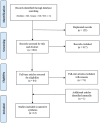Ethical issues in the use of genetic predictions of aggressive behavior in the criminal justice system: a systematic review
- PMID: 40432882
- PMCID: PMC12106298
- DOI: 10.3389/fgene.2025.1599750
Ethical issues in the use of genetic predictions of aggressive behavior in the criminal justice system: a systematic review
Abstract
Background: The use of genetic predictions of aggressive behavior in the criminal justice system remains a subject of ongoing debate. Since behavioral genetic evidence is often used in criminal defense arguments, it is crucial to critically examine the ethical challenges associated with its application.
Objective: This article seeks to identify and analyze these ethical concerns to ensure the responsible and equitable integration of genetic testing, when deemed necessary, into the judiciary system.
Methods: A systematic review was conducted using PubMed, Web of Science, and Scopus, supplemented by manual searches of reference lists to identify additional relevant studies.
Results: The search yielded 1,023 publications, 12 of which met the inclusion criteria. Seven key ethical concerns were identified: the risks of discrimination, stigmatization, eugenic reasoning, deterministic interpretations, overestimation of dangerousness, privacy violations, and medicalization, along with the risks posed by limited scientific literacy among legal professionals.
Conclusion: The ethical challenges associated with genetic predictions of aggressive behavior underscore the need for a critical and multidisciplinary approach to their use in the criminal justice system. Collaboration among bioethicists, legal scholars, scientists, and communication experts is crucial to prevent misuse and reduce potential biases. Such an approach will help ensure that genetic insights are ethically applied, accurately interpreted, and used to promote justice rather than exacerbate systemic inequalities.
Keywords: MAOA gene; behavioral genetics; criminal justice; ethics; genetic testing.
Copyright © 2025 Refolo, Ferracuti, Grassi, Raimondi, Mercuri, Zedda, Aulino, Spagnolo and Oliva.
Conflict of interest statement
The authors declare that the research was conducted in the absence of any commercial or financial relationships that could be construed as a potential conflict of interest. The author(s) declared that they were an editorial board member of Frontiers, at the time of submission. This had no impact on the peer review process and the final decision.
References
-
- Ashby E. (1975). Does XYY mark the crime frontier? Listener 94 (2428), 495–496. - PubMed
-
- Birch D. (1995). Crime, genetics link not found: conference closes amid unusual quiet after weekend protest. Available online at: http://articles.baltimoresun.com/1995-09-25/news/1995268062_1_genetics-v... (Accessed February 25, 2025).
Publication types
LinkOut - more resources
Full Text Sources
Miscellaneous


